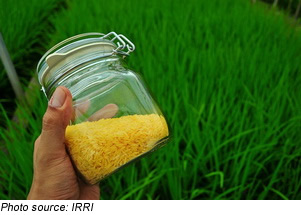
Golden Rice Has Same Nutrients as Traditional Rice Except for the Increased Provitamin A Content
July 10, 2019| |
 Compositional analysis of genetically engineered crops determines significant changes in nutrient composition as compared to its conventional counterpart. A article published in the Journal of Agricultural and Food Chemistry presents the results of the compositional analysis of paddy rice, straw, and bran of biofortified rice (Golden Rice or GR2E) compared with samples of non-transgenic, near-isogenic, control rice (PSBRc82) planted over two growing seasons in the Philippines during 2015-2016 at four locations representing the different rice-growing conditions in the country.
Compositional analysis of genetically engineered crops determines significant changes in nutrient composition as compared to its conventional counterpart. A article published in the Journal of Agricultural and Food Chemistry presents the results of the compositional analysis of paddy rice, straw, and bran of biofortified rice (Golden Rice or GR2E) compared with samples of non-transgenic, near-isogenic, control rice (PSBRc82) planted over two growing seasons in the Philippines during 2015-2016 at four locations representing the different rice-growing conditions in the country.
The grain samples were analyzed for key nutritional components such as fiber, sugars, fatty acids, amino acids, vitamins, minerals, proximates, and anti-nutrients. The results showed that the only biologically significant difference between Golden Rice and the conventional rice was the amount of beta carotene (vitamin A precursor) and other provitamin A carotenoids in the grain. The rest of the compositional parameters were found to be within the range of natural variability of conventional rice varieties with a history of safe consumption. The average concentration of provitamin A concentrations in milled Golden Rice can contribute up to 89-113% and 57-99% of the vitamin A requirement for pre-school children in Bangladesh and the Philippines, respectively.
Read the research article in the Journal of Agricultural and Food Chemistry.
| |
Biotech Updates is a weekly newsletter of ISAAA, a not-for-profit organization. It is distributed for free to over 22,000 subscribers worldwide to inform them about the key developments in biosciences, especially in biotechnology. Your support will help us in our mission to feed the world with knowledge. You can help by donating as little as $10.
-
See more articles:
-
News from Around the World
- Nigeria Needs More Community Engagement on GM Cotton from Agricultural Extension Workers
- Curriculum Reforms in Uganda Integrate Modern Biosciences
- Mozambique to Gain from Using GM Maize, Research Reveals
- Researchers Map Vegetable Family Tree
- Breakthrough Finds Plant Nutrient Detector
- Scientists Discover How Plants Breathe
- Change Needed for Europe's Assessment and Approval Process for Genome‐Edited Crops
-
Research Highlights
- Golden Rice Has Same Nutrients as Traditional Rice Except for the Increased Provitamin A Content
-
Beyond Crop Biotech
- Japanese Geneticists Favor New Policies for Genome Editing Applications, Survey
-
From the BICs
- Project SAFFAL Reaches Farmers Affected by Fall Armyworm in Karnataka
-
Announcements
- 6th Plant Genomics and Gene Editing Congress: Asia (10% Discount for CBU Subscribers)
-
Plant
- EU Commissioner Vytenis Andriukaitis on the Potential of Gene Editing
- Genome Editing Could be Used to Engineer Resistance to Virus and Cold-induced Sweetening in Potato
- Scientists Finally Record Successful Mitochondrial DNA Editing in Plants
- Researchers Use Virus in Wheat and Maize Genome Editing
-
Read the latest: - Biotech Updates (December 10, 2025)
- Gene Editing Supplement (November 26, 2025)
- Gene Drive Supplement (February 22, 2023)
-
Subscribe to BU: - Share
- Tweet
